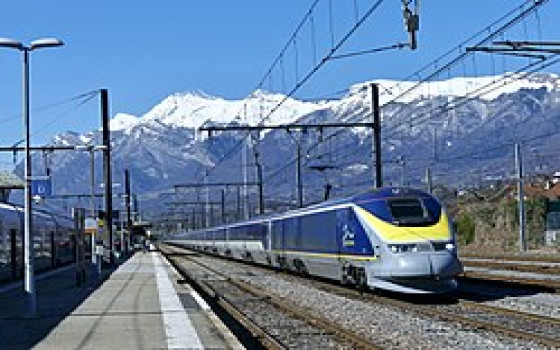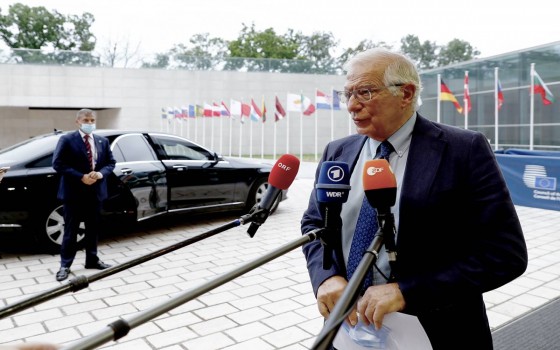
To develop the Trans-European Transport Network (TEN-T)...an agreement to ensure sustainable connectivity and link 424 major cities with ports, airports and railways.

- Europe and Arabs
- Tuesday , 19 December 2023 14:12 PM GMT
Brussels: Europe and the Arabs
The Presidency of the Council of the European Union, which represents member state governments, and European Parliament negotiators have reached a provisional agreement on a revised regulation on EU guidelines for the development of the Trans-European Transport Network (TEN-T).
The new legislation aims to build a reliable, seamless and high-quality transport network that ensures sustainable connectivity throughout Europe without physical interruptions, bottlenecks and lost links.,
“Today’s agreement is a milestone for better and sustainable connectivity in Europe,” said Oscar Puente, Spain’s Minister of Transport and Sustainable Mobility, whose country holds the EU’s rotating presidency. “The TEN-T guidelines are a key tool for EU transport policy that will contribute significantly to strengthening the cohesion of the Union.” European and stimulating growth and job opportunities.
This network will contribute to achieving the objectives of sustainable mobility of the European Union, the sound functioning of the internal market and the economic, social and regional cohesion of the European Union. The network will be developed or upgraded step by step with the new regulation setting clear deadlines for the completion of the three-layer TEN-T network: the core network must be completed by 2030, the newly added expanded core network by 2040 and the comprehensive network by 2040. 2050.
Regarding the main elements of the interim agreement, according to a European statement distributed in Brussels, the interim agreement maintains the comprehensive ambition to develop a coherent, connected, and high-quality transport infrastructure across the European Union, taking into account the different starting points in the member states, in addition to their priorities and methods towards greener transport. Member States will decide how to prioritize projects of common interest in line with realistic technical requirements and priority aimed at creating a unified, high-performance and fully interoperable infrastructure to contribute to the decarbonisation of the transport sector and its multimodality. These requirements, as set out in the new regulation, are commensurate with the expected benefits, jobs and investments required by Member States. The Interim Agreement also takes into account the financial resources available to Member States, as well as the investment needs for infrastructure development, which could be very significant, especially with regard to the comprehensive TEN-T network.
As for communication with the main neighboring countries, the statement said that in response to the impact of the Russian aggressive war on Ukraine and to ensure better communication with the main neighboring countries, the new regulation expands four European transport corridors of the TEN-T network to Ukraine and Moldova while reducing the level of cross-border communications with Russia and Belarus.
Regarding the next steps, the statement explained that after the temporary agreement reached, work on the revised regulations will continue at the technical level. Once this work is completed, the Presidency intends to pass the text to representatives of Member States (Coreper) for approval.
The legislative act will then have to undergo careful legal/linguistic review before it is formally adopted by the participating legislators and entered into force.
TEN-T is an EU-wide network of railways, inland waterways, short sea shipping routes and roads. It connects 424 major European cities with ports, airports and railway stations. When TEN-T is completed, travel times between these cities will be reduced. For example, passengers will be able to travel between Copenhagen and Hamburg in two and a half hours by train, instead of the 4.5 hours required today.
The Commission adopted the revised regulation proposal on 13 December 2021 as part of the legislative package for efficient and green mobility. The Commission's proposal paid particular attention to a new governance structure for TEN-T and intermodal policy by setting ambitious targets, in particular regarding the development of railway infrastructure. In response to the impact of Russia's war of aggression on Ukraine, the Commission adopted a revised proposal on 27 July 2022 making several changes to the initial text. The revised proposal calls for standardizing the TEN-T network using a standard European railway track gauge. It also strives to improve the connectivity of Ukraine and the Republic of Moldova with the European Union by expanding relevant European transport corridors.
After discussions at technical level throughout 2022, and submitting a progress report to the TTE/Transport Board on 2 June 2022, the Council reached a general approach by consensus at the TTE/Transport Board on 5 December 2022. In the European Parliament (EP), the TRAN Committee voted on the report on 14 April 2023, and the decision to enter into inter-institutional negotiations on this basis was confirmed at the plenary session held on 19 April. The negotiations began under the leadership of Sweden on April 24, 2023












No Comments Found